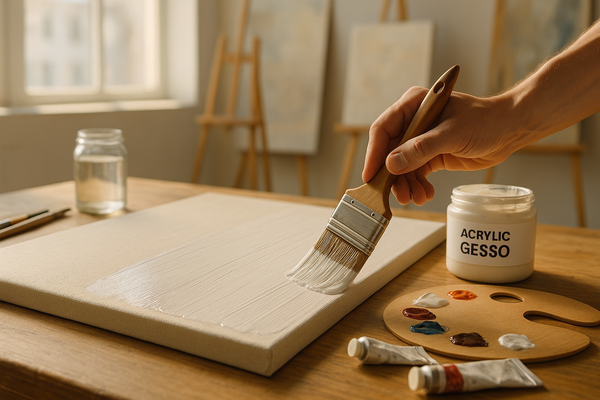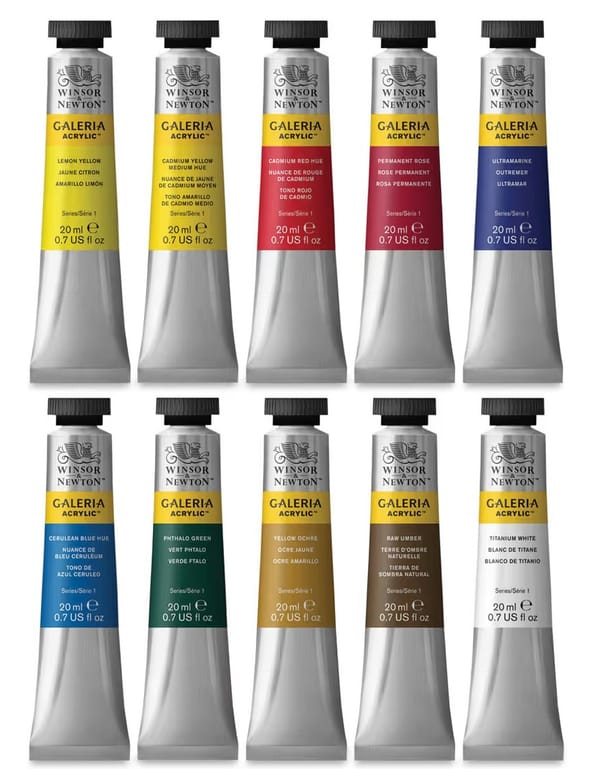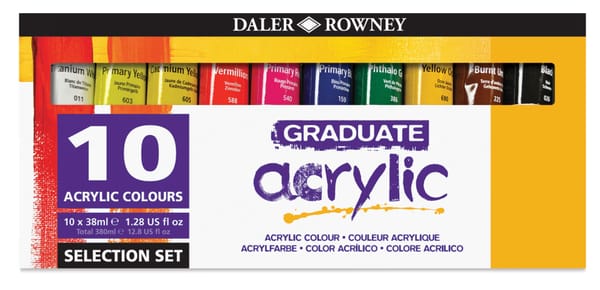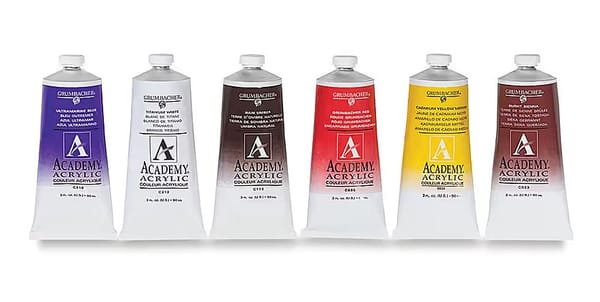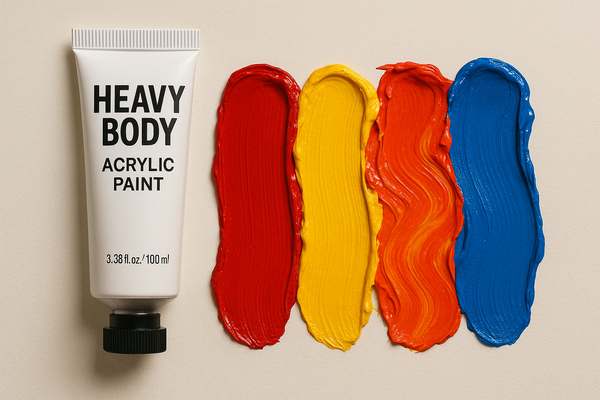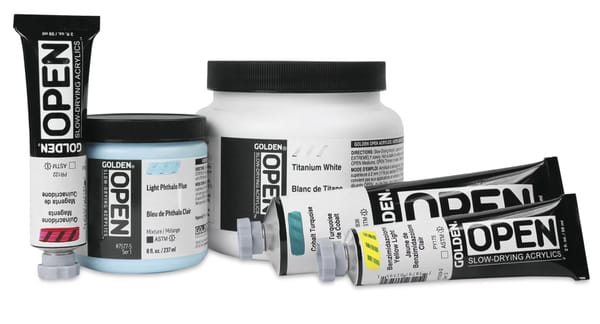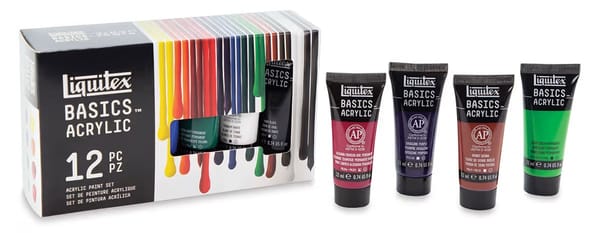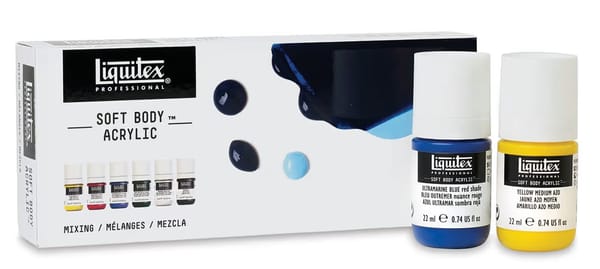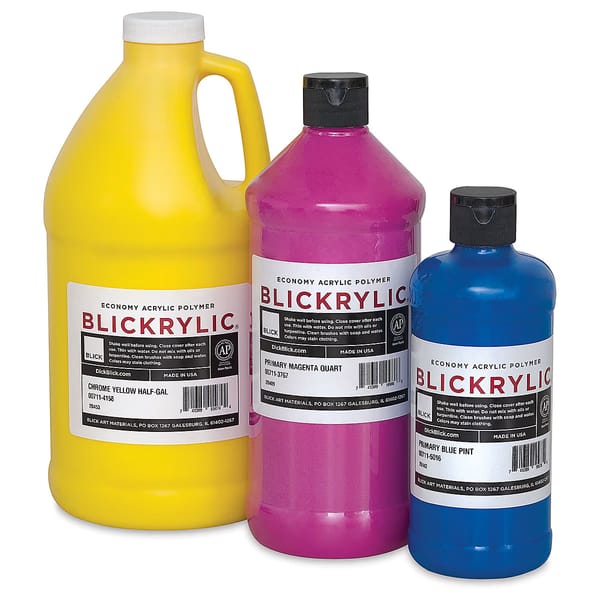Best Acrylic Paints for Every Medium and Skill Level
From student sets to pro formulas, explore the best acrylic paints for blending, texture, and technique. Find your match now.

Choosing the best acrylic paints should feel easy, not overwhelming. This guide explains how acrylics work, compares the main types, and matches them to skill levels and painting surfaces. You'll also find top product picks from Blick, helpful checklists, and pro tips for building a reliable studio setup.
What Makes Acrylic Paints Different?
Acrylics combine pigment, water, and an acrylic polymer binder. As the water evaporates, the binder forms a flexible, durable film. Because of this, it cleans up with water, dries quickly, and resists cracking. It also works with gels and mediums that adjust texture, gloss, or drying time.
Moreover, the best paints strike a balance between pigment strength and smooth flow, ensuring a steady drying process. Artists value how predictable they feel, fast recoats, strong adhesion, and even layers. This makes acrylics suitable for glazing, impasto, mixed media, or classroom work. Their versatility explains why many artists choose them first.
Acrylic vs. Oil vs. Watercolour — What Artists Choose and Why
What Are the Different Types of Acrylic Paint Sets?
Before buying, consider how you like paint to feel. A set may include several textures or viscosities. Thicker paints emphasize texture, while fluid types create fine details and smooth, layered effects. Meanwhile, open-time versions give more blending time before drying.
Heavy Body Acrylics
These paints hold visible brush marks and peaks. They work well for impasto, sgraffito, and sculptural textures. Because they mix easily with gels, you can build height without losing colour strength. For clean details, thin them slightly with medium, not with too much water.
Soft Body / Fluid Acrylics
Fluid pigments are evenly dispersed and become smooth films. These acrylic paint set work best in line, glazing, and layering of colours. On smooth walls or flat panels, they can be moved using a minimum amount of brush drag. The transparency of the test must be checked initially because various brands have different pigment loads and coverage.
Acrylic Ink
Acrylic inks have a thin, ink-like flow. They're great for dip pens, markers, and airbrushes. Once dry, they become waterproof, allowing for clean layering. When pouring, use a pouring medium instead of water to maintain strength and avoid cracking.
Interactive / Open Acrylics
These stay wet longer on the palette and surface. As a result, they allow for smooth gradients and soft transitions, much like oil paint. They're ideal for workshops and detailed blending. However, give them extra time to cure before varnishing or applying a mask.
How to Choose Acrylic Paints by Skill Level?
Matching paint to your skill level saves time and helps you improve faster. Use this guide to find the best fit for you. Additionally, consider factors such as drying speed, pigment richness, and the amount of paint required.
For Beginners
Begin with a paint set that includes primary colours, earth tones, and white. These paints are affordable, easy to mix, and forgiving. They help beginners learn brush control and colour blending without worrying about cost or waste.
For Intermediate Artists
If you already understand layering and mixing, try the best acrylic paints, which offer better pigment and texture balance. They offer consistent drying and higher opacity. Mixing heavy and fluid paints lets you combine bold strokes with precise details.
For Professionals
Advanced painters rely on paints that maintain colour for decades. Professional-grade paint has richer pigment and smoother finish options. Although pricier, it covers more area per ounce. Plan for longer drying times when using open formulas for detailed projects.
Top Paints to Choose From
Each line below offers a distinct feel and purpose. Choose based on your technique, texture preference, and budget. All five are trusted choices available on Blick.
Golden Heavy Body Acrylics
This line is buttery, richly pigmented, and ideal for knife work. The thick consistency supports textured builds without colour loss when mixed with gels. It's a favourite among professionals for expressive layers and strong coverage.
Liquitex Professional Heavy Body
These paints provide thick, smooth films and reliable colour strength. Many artists call them some of the best acrylic paints for precision, sharp masking, and consistent drying on primed canvas or panels.
Golden Fluid Acrylics
This type flows easily yet stays strong when thinned. It excels in glazing, airbrushing, and fine brushwork. Artists who value accuracy over heavy texture often choose these for even, luminous layers.
Winsor & Newton Galeria
A budget-friendly option with good permanence. Galeria paints offer balanced performance for students and studios. They dry evenly and handle well from underpainting to varnish stages.
Blick Artists' Acrylics
Consistent viscosity, solid lightfastness, and excellent pricing make these versatile. For large panels or teaching environments, this brand maintains high quality while controlling costs.
How to Choose the Best Acrylic Paint for Your Medium
Your painting surface affects how paint behaves. Therefore, select a viscosity and medium that match your support. Since the paint dries differently on each material, testing small areas helps avoid surprises.
Canvas: Heavy Body for Bold Texture, Fluid for Layering
Use thick acrylic paint to achieve a raised texture, or apply fluid paint to create a smooth texture. Canvass sustains the two with good priming.
Wood: Primer + Soft Body for Smooth Coverage
Cover all sides of the wood to prevent warping. Apply a lighter paint to cover the painting smoothly, and sand between the layers slightly.
Paper: Fluid or Ink Acrylics for Control and Detail
Use thicker papers that are not easily warped. The acrylics in fluids are applicable in fine lines and clear layers.
Fabric or Mixed Media: Flexible Medium-Enhanced Paints
Mix with fabric or flexible mediums for soft, durable results. Collage and textured art benefit from adhesion-promoting gels.
Factors to Consider Before Buying Acrylic Paint
Keep these basics in mind before making a purchase. The best acrylic paints match your workflow, texture needs, and longevity expectations.
- Pigment load and opacity
- Drying time and blendability
- Finish (matte, satin, gloss)
- Lightfastness (fade resistance)
- Compatibility with media and gels
- Brand reliability and batch consistency
Expert Tips for Using the Paints Like a Pro
Small habits make big improvements. These tips keep your paintings clean, vibrant, and long-lasting.
- Prepare your surface with primer or gesso for improved adhesion and colour brilliance.
- Mist your palette lightly to keep paint moist without over-thinning.
- Combine complementary colours to increase the range of the palette and add depth.
- Wipe brushes as soon as possible to prevent the paint from drying in them.
Frequently Asked Questions
What's the Best Acrylic Paint Brand for Beginners?
Select a student-grade paint set with clear labelling and a balanced viscosity. Sets with primaries, earth colours, and white help beginners learn colour mixing affordably.
Can I Mix Different Brands of Acrylic?
Yes, but formulas differ slightly. Test small mixes first to check consistency, sheen, and drying rate before applying to finished work.
What's the Difference Between Heavy and Fluid Acrylics?
Heavy-body paints hold brush strokes and texture, while fluid acrylics level smoothly. Combining both offers texture and precision in one composition.
Do I Need to Prime Surfaces Before Using Acrylic?
Priming improves adhesion and colour evenness. It also prevents warping on wood and keeps edges clean on canvas.
How Long Do Acrylic Paints Last Once Opened?
When sealed tightly and stored in a cool space, they can last for years. If separation occurs, stir thoroughly before use.

